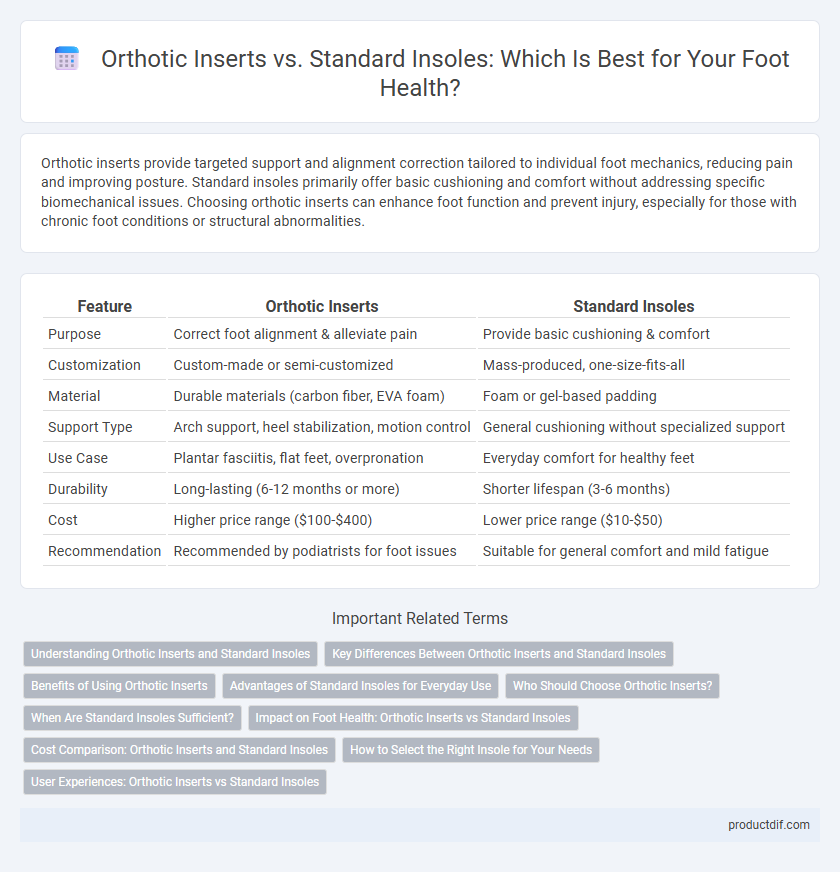Orthotic inserts provide targeted support and alignment correction tailored to individual foot mechanics, reducing pain and improving posture. Standard insoles primarily offer basic cushioning and comfort without addressing specific biomechanical issues. Choosing orthotic inserts can enhance foot function and prevent injury, especially for those with chronic foot conditions or structural abnormalities.
Table of Comparison
| Feature | Orthotic Inserts | Standard Insoles |
|---|---|---|
| Purpose | Correct foot alignment & alleviate pain | Provide basic cushioning & comfort |
| Customization | Custom-made or semi-customized | Mass-produced, one-size-fits-all |
| Material | Durable materials (carbon fiber, EVA foam) | Foam or gel-based padding |
| Support Type | Arch support, heel stabilization, motion control | General cushioning without specialized support |
| Use Case | Plantar fasciitis, flat feet, overpronation | Everyday comfort for healthy feet |
| Durability | Long-lasting (6-12 months or more) | Shorter lifespan (3-6 months) |
| Cost | Higher price range ($100-$400) | Lower price range ($10-$50) |
| Recommendation | Recommended by podiatrists for foot issues | Suitable for general comfort and mild fatigue |
Understanding Orthotic Inserts and Standard Insoles
Orthotic inserts are custom-designed devices that provide targeted support and correct biomechanical foot issues, whereas standard insoles offer general cushioning and comfort without specialized alignment benefits. Orthotics address specific conditions such as flat feet, plantar fasciitis, or overpronation, improving foot function and reducing pain. Standard insoles primarily enhance shock absorption and are suitable for everyday comfort but do not correct structural foot problems.
Key Differences Between Orthotic Inserts and Standard Insoles
Orthotic inserts provide customized support tailored to the individual's foot structure and specific biomechanical needs, whereas standard insoles offer generic cushioning and comfort without personalized alignment correction. Orthotics are designed to correct issues such as overpronation, plantar fasciitis, and flat feet, while standard insoles mainly serve to enhance overall foot comfort and reduce fatigue. The materials used in orthotic inserts are typically more rigid and durable for structural support, contrasting with the softer, flexible foam or gel found in standard insoles.
Benefits of Using Orthotic Inserts
Orthotic inserts provide customized support that aligns the foot's structure, reducing pain and preventing injuries caused by improper gait or foot mechanics. They improve overall comfort during prolonged standing or walking by distributing pressure evenly across the foot, which standard insoles often fail to achieve. Enhanced stability and correction of biomechanical issues with orthotic inserts contribute to long-term foot health and improved posture.
Advantages of Standard Insoles for Everyday Use
Standard insoles offer enhanced cushioning and shock absorption, improving overall comfort during daily activities. Their lightweight design and breathable materials promote better foot ventilation, reducing moisture and odor buildup. Widely compatible with most footwear, standard insoles provide an easy, affordable solution for everyday foot support without the need for custom adjustments.
Who Should Choose Orthotic Inserts?
Orthotic inserts are ideal for individuals with specific foot conditions such as plantar fasciitis, flat feet, or high arches, providing targeted support and correcting biomechanical imbalances. Athletes and people who experience chronic foot pain or require enhanced arch support benefit most from custom orthotics designed to improve comfort and prevent injury. Standard insoles offer general cushioning but lack the specialized structure needed for correcting foot posture or alleviating structural foot issues.
When Are Standard Insoles Sufficient?
Standard insoles are sufficient for individuals experiencing mild foot discomfort, general arch support needs, or basic cushioning during everyday activities. They effectively provide shock absorption and relief for common foot fatigue without the need for custom adjustments. For those without structural foot issues or chronic pain, standard insoles offer an affordable and convenient solution to enhance overall comfort in footwear.
Impact on Foot Health: Orthotic Inserts vs Standard Insoles
Orthotic inserts provide customized support that corrects biomechanical imbalances, alleviating foot pain and preventing conditions such as plantar fasciitis and flat feet. Standard insoles offer basic cushioning but lack the tailored structural support necessary to address specific foot ailments or improve overall foot alignment. Investing in orthotic inserts can significantly enhance foot health by promoting proper weight distribution and reducing strain on muscles and joints.
Cost Comparison: Orthotic Inserts and Standard Insoles
Orthotic inserts typically cost between $100 and $500 due to their custom-fitted design tailored to individual foot anatomy, while standard insoles range from $10 to $50 and provide general cushioning without customization. Insurance may cover part of the expense for orthotic inserts when prescribed by a healthcare professional, making them a more cost-effective option for long-term foot health. Despite higher initial costs, orthotic inserts offer targeted support that can reduce future medical expenses related to foot, knee, or back pain.
How to Select the Right Insole for Your Needs
Selecting the right insole for your needs requires evaluating factors such as arch support, cushioning, and material durability. Orthotic inserts provide customized alignment and pain relief for specific foot conditions like plantar fasciitis, while standard insoles offer general comfort and shock absorption. Consider consulting a podiatrist to accurately assess your foot structure and activity level, ensuring optimal support and injury prevention.
User Experiences: Orthotic Inserts vs Standard Insoles
Orthotic inserts provide targeted support and pain relief by addressing specific foot conditions such as plantar fasciitis and flat feet, significantly improving comfort during prolonged wear. Standard insoles primarily offer basic cushioning and shock absorption but often lack the custom fit necessary for individuals with unique biomechanical needs. Many users report enhanced stability and reduced foot fatigue with orthotic inserts compared to standard insoles, which may not adequately prevent overpronation or supination.
Orthotic Inserts vs Standard Insoles Infographic

 productdif.com
productdif.com